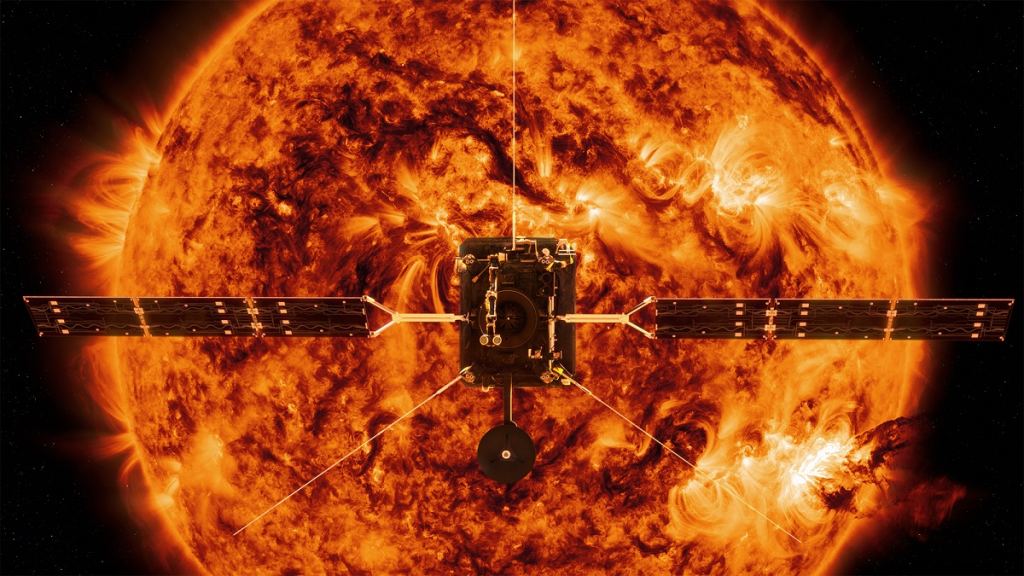On February 10th, 2020, the ESA's Solar Orbiter (SolO) launched and began making its way towards our Sun. This mission will spend the next seven years investigating the Sun's uncharted polar regions to learn more about how the Sun works. This information is expected to reveal things that will help astronomers better predict changes in solar activity and "space weather".
Last week (on Thursday, Feb. 13th), after a challenging post-launch period, the first solar measurements obtained by the SolO mission reached its international science teams back on Earth. This receipt of this data confirmed that the orbiter's instrument boom deployed successfully shortly after launch and that its magnetometer (a crucial instrument for this mission) is in fine working order.
The SolO mission carries a total of ten instruments that are part of its advanced scientific suite, a combination of imagers, remote, and in-situ sensors. Four of these instruments are designed to measure properties of the environment around the spacecraft, particularly the electromagnetic characteristics of the solar wind (the stream of charged particles constantly emanating from the Sun).
Three of these in situ instruments have sensors located on the spacecraft's 4.4 m-long (~14.5 ft) titanium/carbon-fiber boom, which was extended on Wednesday (Feb. 12th). However, two of the magnetometer's sensors had been switched on already (21 hours after launch) by their operators at the European Space Operations Centre in Darmstadt, Germany.
Having these sensors active before and after the extension of the boom allowed the science team to gather vital data on how a spacecraft can influence measurements taken in the space environment. Tim Horbury of Imperial College London, who is the Principal Investigator for the Magnetometer instrument (MAG), explained the importance of this in a recent ESA press release:
“We measure magnetic fields thousands of times smaller than those we are familiar with on Earth. Even currents in electrical wires make magnetic fields far larger than what we need to measure. That’s why our sensors are on a boom, to keep them away from all the electrical activity inside the spacecraft... “The data we received shows how the magnetic field decreases from the vicinity of the spacecraft to where the instruments are actually deployed. This is an independent confirmation that the boom actually deployed and that the instruments will, indeed, provide accurate scientific measurements in the future.”
As the boom extended over a 30-minute period, the scientists observed the extent to which the magnetic field decreased, which was one order of magnitude. Just prior to the boom's extension, the magnetic fields observed by the operators were mostly those being generated by the spacecraft. By the end of the procedure, they got their first look at the significantly weaker magnetic field in the surrounding environment.
Matthieu Kretzschmar from the Laboratoire de Physique et Chimie de l'Environnement et de l'Espace (LPC2E) in Orleans, France, is also the Lead Co-investigator of another boom-mounted sensor, known as the Radio and Plasma Waves instrument (RPW) instrument. As he summarized the importance of these measurements:
"Measuring before, during, and after the boom deployment helps us to identify and characterize signals that are not linked to the solar wind, such as perturbations coming from the spacecraft platform and other instruments. " The spacecraft underwent extensive testing on ground to measure its magnetic properties in a special simulation facility, but we couldn’t fully test this aspect until now, in space, because the test equipment usually prevents us from reaching the needed very low level of magnetic field fluctuations."
Before the instrument can be used to fulfill its primary purpose (i.e. studying the magnetic field of the Sun) it will need to undergo some serious calibration to make sure it's working properly. According to SolO's operators, this will take place between now and the end of April, and they hope to begin collecting scientific data by mid-May.
In addition to the instrument boom, the three antennas of the Radio and Plasma Waves (RPW) instrument were also deployed in the early hours of February 13th. This instrument is designed to study the characteristics of electromagnetic and electrostatic waves in the solar wind. As Yannis Zouganelis, the deputy project scientist for the SolO mission, said:
"The remote-sensing instruments will be commissioned in the coming months, and we look forward to testing them further in June, when Solar Orbiter gets nearer to the Sun."
The combination of in-situ imagers, magnetometers, and radio wave and plasma measurements will allow scientists to observe the link between events on the Sun's surface to phenomena detected in solar wind. This will help astronomers unlock the mysteries of solar activity, such as the 11-year solar cycle, the generation of the Sun's magnetic field, and how solar wind particles are accelerated to high energies.
"The ten instruments onboard our mission will be playing together like instruments in an orchestra," said ESA Solar Orbiter project scientist Daniel Müller. "We have just started the rehearsal, and one by one, additional instruments will join. Once we are complete, in a few months' time, we will be listening to the symphony of the Sun."
In the coming years, the SolO mission will be working collaboratively with NASA's Parker Solar Probe to provide the most detailed picture of the Sun in the history of solar astronomy. This will include data on its previously unstudied polar regions, the magnetic and plasma environment that surrounds it, and the mechanisms that heat the Sun's corona and accelerate solar wind particles.
*Further Reading: ESA*
 Universe Today
Universe Today


